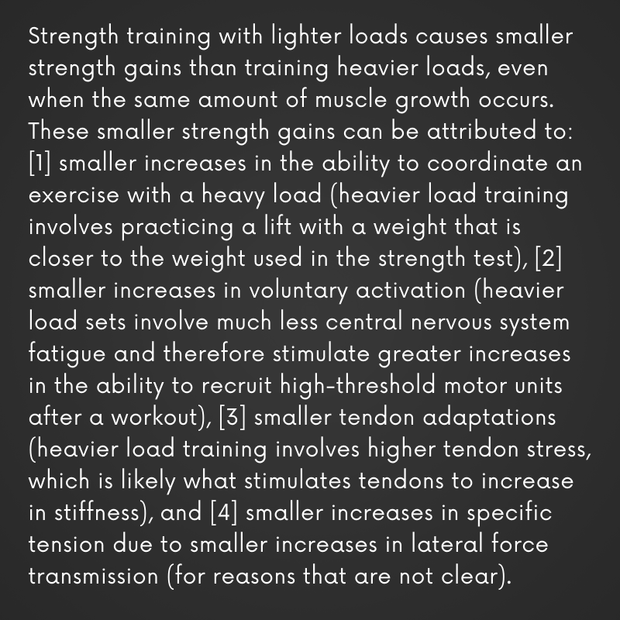
Strength training with light loads causes smaller strength gains than training with moderate or heavy loads, even when it produces the same amount of muscle growth. Exactly why strength gains are smaller when using light loads is not entirely clear, although there are several likely mechanisms.

.
Indeed, research into why light loads might cause smaller strength gains has shown that lighter load training tends to produce smaller increases in (1) coordination in the exercise performed with a heavy load, (2) voluntary activation (which is the ability to recruit high-threshold motor units), (3) tendon stiffness (which can affect strength because of the effects of tendon lengthening and shortening on the force-velocity relationship of muscle fibers), and (4) specific tension of the muscle (which might theoretically be affected by the amount of lateral force transmission or the level of myofibrillar density).
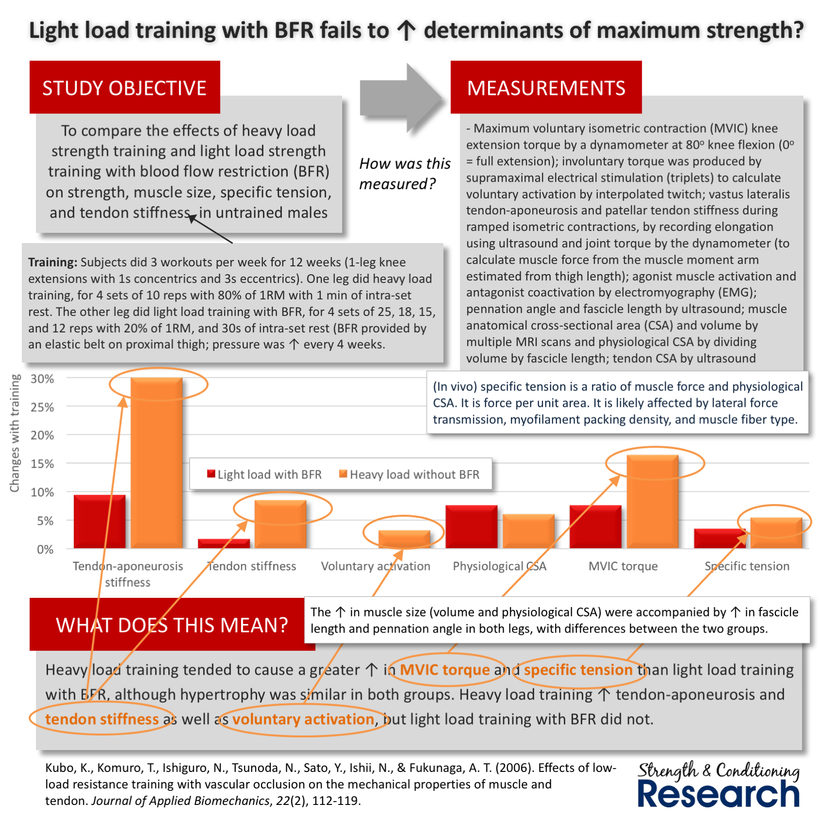 .
.
So why does light load training produce smaller strength gains? What are the mechanisms?
.
#1. Coordination is load-specific
Although there is relatively little research available to demonstrate the fact, it is very likely that lighter load strength training causes smaller increases in maximum strength than heavier load strength training because of smaller improvements in coordination. Indeed, while gains in task-specific strength and non task-specific strength are both greater after heavier load strength training than after lighter load strength training, the difference between loads is more noticeable in respect of task-specific strength. This suggests that coordination is improved more after heavier load strength training.

.
It is actually fairly logical that heavier load strength training should cause superior improvements in coordination, since the motor control problem of lifting a heavier weight is different from the motor control problem of lifting a lighter weight if only because heavier weights require greater stabilization of the rest of the body, which is produced by synergist muscle activation. Consequently, practicing lifting heavy weights allows practice for these synergists in contributing to stabilizing the body during maximal weight attempts.
.
#2. Voluntary activation (the ability to recruit high-threshold motor units)
Lighter load strength training certainly does not increase the ability to recruit high-threshold motor units after training to the same extent as heavier load strength training. This has been demonstrated in studies that have used the gold standard measurement method of voluntary activation, rather than the less reliable measurement method involving surface electromyography. This probably happens because lifting light loads to failure does not produce an increase in the ability to recruit high-threshold motor units because each set involves slightly higher levels of central nervous system (CNS) fatigue than similar sets with heavier loads.
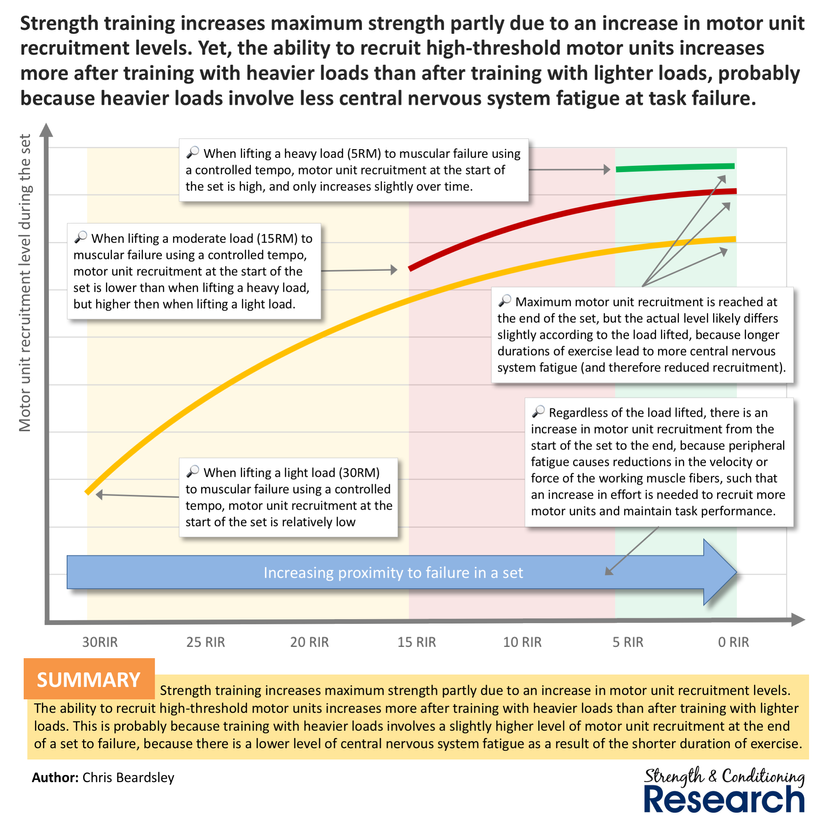
.
Indeed, this greater amount of CNS fatigue has been noted on several occasions.
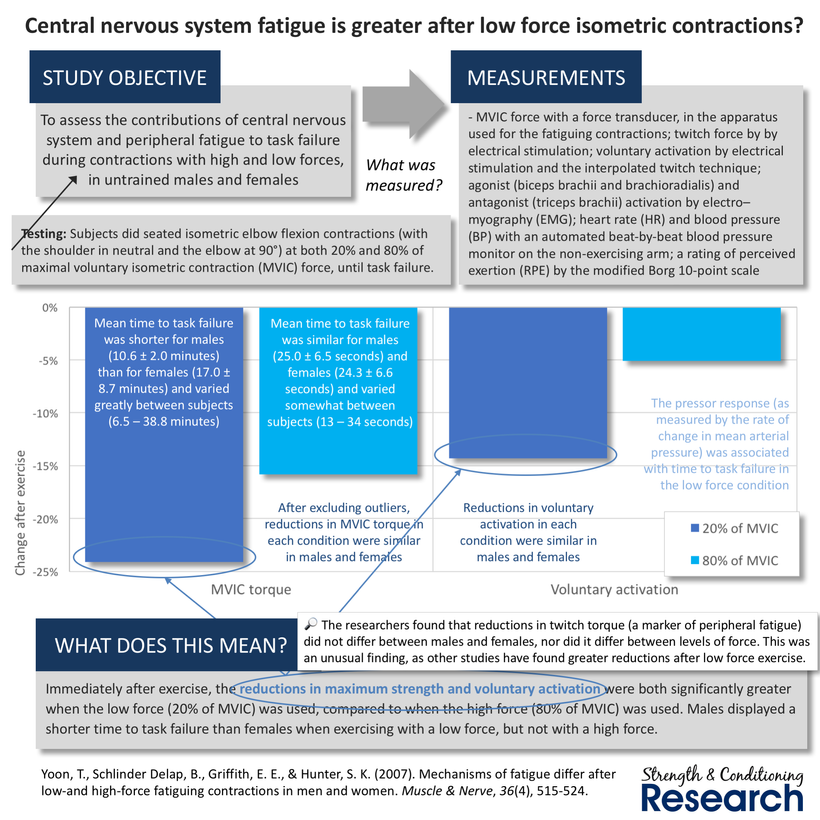
.
And again.
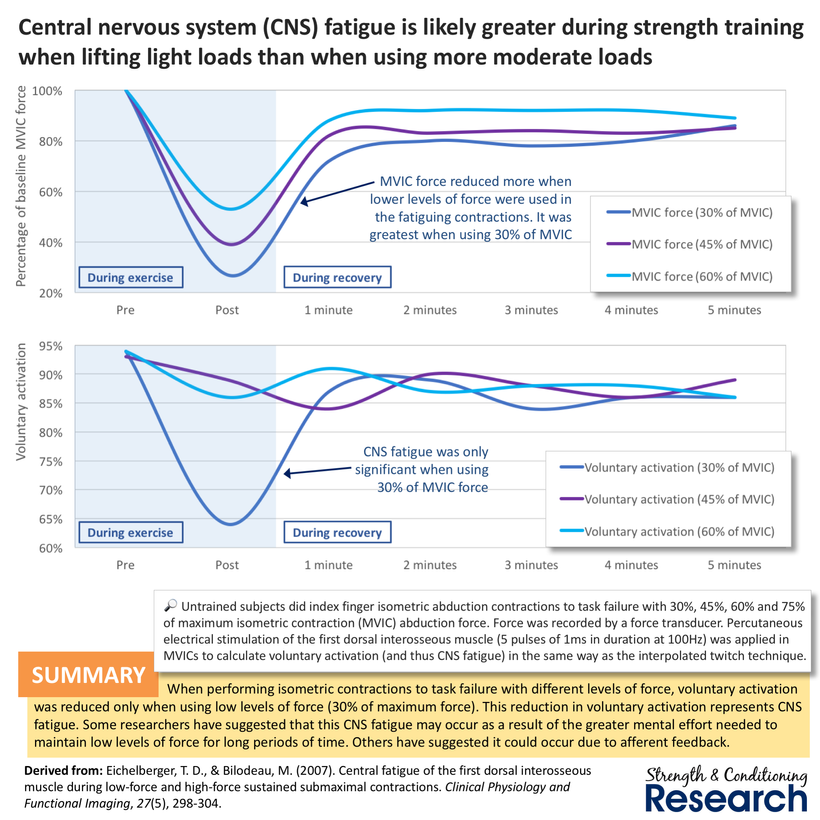
.
And more recently.

.
#3. Tendon stiffness
During isometric and concentric-only contractions, more compliant tendons lead to muscle-tendon units producing a smaller force for a given joint angular velocity. This most likely occurs because of the force-velocity relationship. When a tendon is more compliant, it actually lengthens slightly once a muscle begins producing force in series with it. Consequently, the muscle shortens faster than would be expected. The faster shortening means that it produces less force, due to the formation of fewer actin-myosin crossbridges.
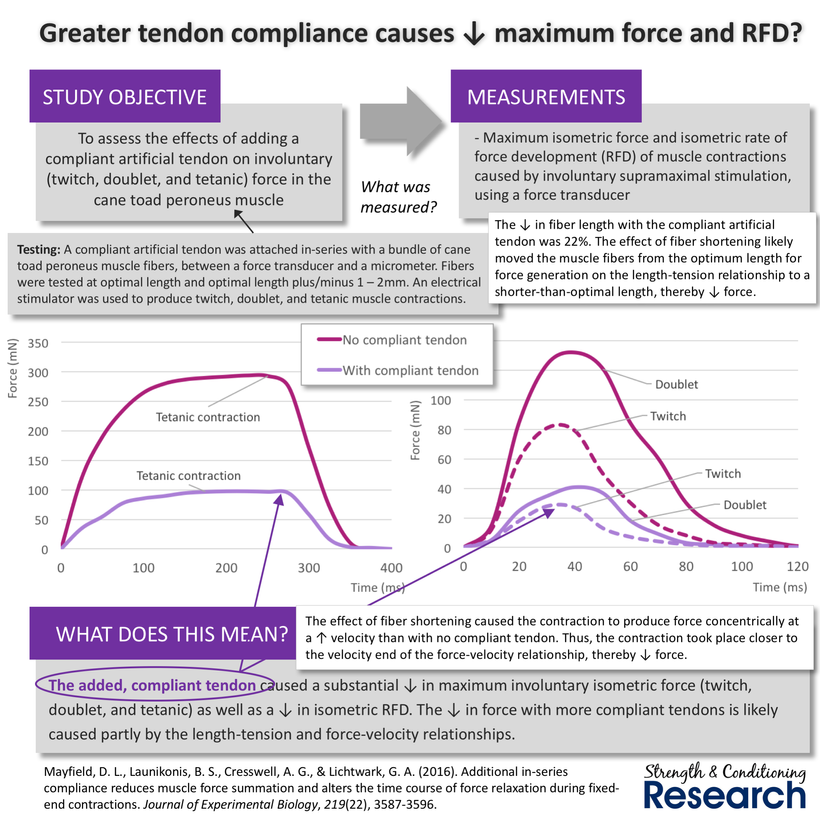
.
Research has shown that tendons increase their stiffness in response to exercise, and that these increases are dependent upon the load that is used. Moderate (and heavy) load strength training increases tendon stiffness, while light load strength training does not.
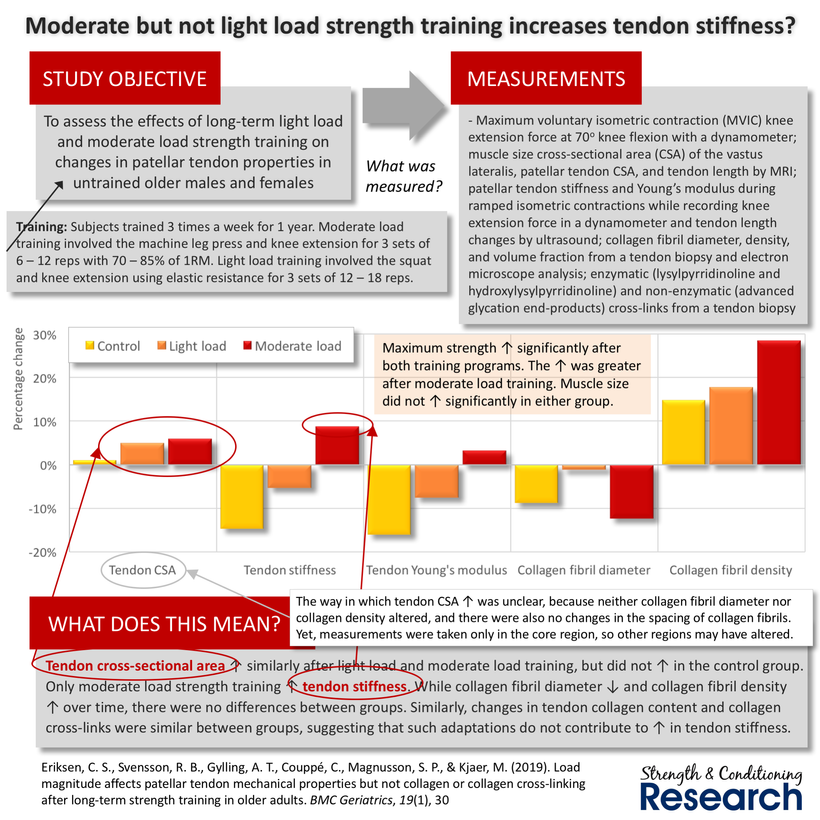
.
Exactly what causes this increase in tendon stiffness to occur after exercise is not known, although it is widely agreed to be a mechanical stimulus rather than a metabolic one. Interestingly, tendons can experience both stress (force per unit cross-sectional area) and strain (percentage length change) during exercise in different amounts. Some types of exercise produce a lot of stress but little strain (such as strength training with heavy loads) while other types produce a lot of strain but little stress (such as plyometrics with light loads).
In general, the research shows that tendon stiffness adapts to a greater extent when tendon stress is high (while tendon strain is minimal) during exercise. For example, tendon stiffness adaptations are greater after isometric training than after dynamic heavy strength training, and they are greater after dynamic heavy strength training than after plyometrics training. This suggests that tendon stress (rather than strain) is the key factor that stimulates increases in tendon stiffness.

.
#4. Specific tension
Specific tension refers to the strength of a muscle fiber relative to its size, either because of an increase in myofibrillar density or because of an increase in lateral force transmission. Heavier load strength training seems to cause greater increases in specific tension than lighter load strength training. Exactly how this occurs is very unclear.
In older textbooks, it was often written that heavier load strength training might increase strength to greater extent than lighter load strength training by a larger increase in myofibrillar density. Yet, this idea fell out of favor for a long time after a series of studies found no changes in myofibrillar density after strength training. More recently, a couple of studies have rekindled interest in this area, since they have shown changes in myofibrillar density after strength training, as well as a higher level of myofibrillar density in strength-trained individuals compared to untrained people. Even so, these studies have not found any effect of load on the changes in myofibrillar density, so this is unlikely to be an explanation for the different effects of lighter and heavier loads on specific tension.
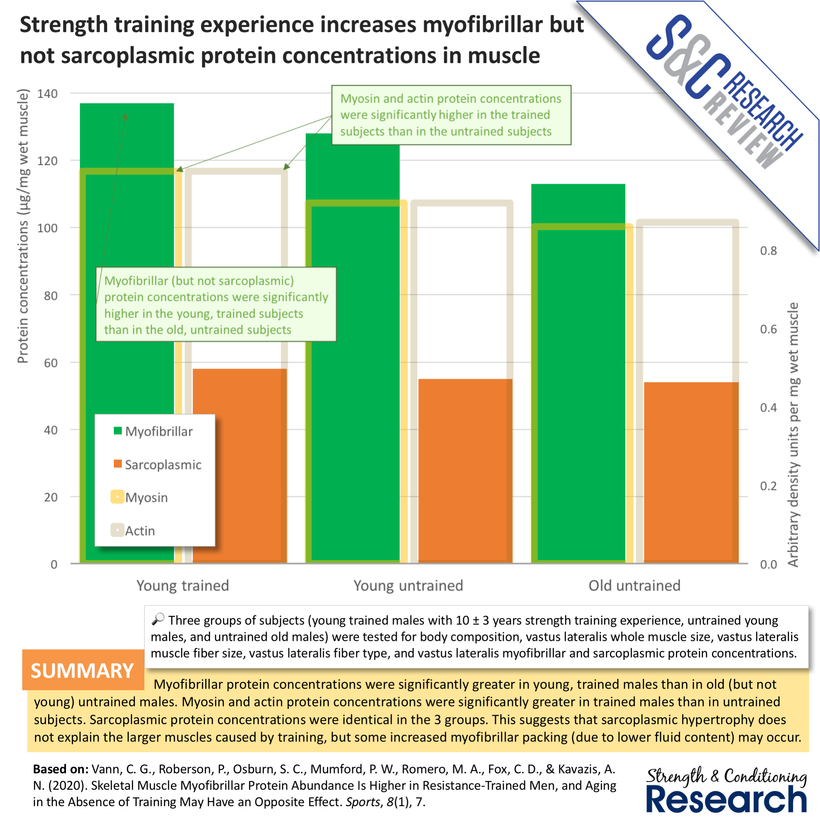
.
Depending on the measurement method, specific tension can be affected by (1) only myofibrillar density, or by (2) both myofibrillar density and the amount of lateral force transmission. When measurements are taken of single muscle fibers in isolation (without their collagen layers attached), the specific tension can only be affected by myofibrillar density. When measurements are taken of muscle fibers in situ with their collagen layers attached, the specific tension can be affected by both myofibrillar density and lateral force transmission.
Most of the time, increases in specific tension that occur after strength training are only apparent when measuring muscle fibers with their collagen layers still attached. It is actually quite rare for muscle fibers to display changes in strength relative to size as a result of strength training. Indeed, a recent study in this area found that bodybuilders and untrained individuals display similar specific tension of single muscle fibers.

.
In contrast, when measurements are taken with muscle fibers still attached to their surrounding collagen layers, specific tension increases are observed, and they appear to contribute substantially to strength gains. The increase in specific tension seems to occur due to an increase in the amount of force that is transmitted laterally from the sarcomeres of the muscle fiber to the surrounding collagen layer.
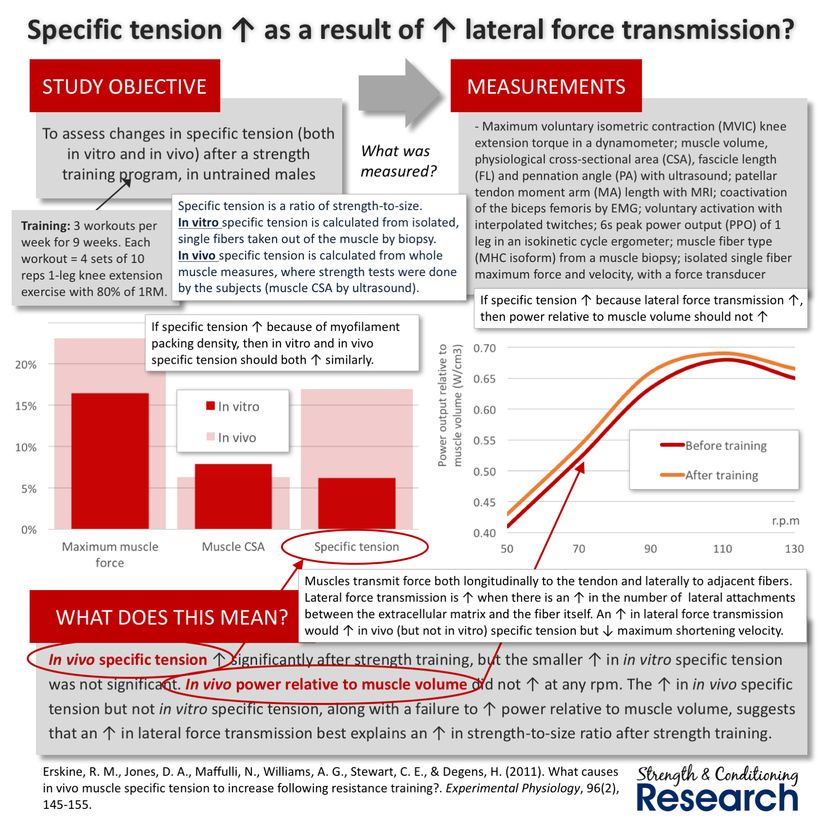
.
Indeed, most (but not all) of the force that a muscle fiber produces is transmitted laterally instead of longitudinally. When adaptations occur that increase the proportion of force that is transmitted laterally, this seems to cause an increase in maximum strength. The main adaptation that produces this effect seems to be an increase in the number of costameres that link the sarcomeres with the surrounding collagen layer. However, what triggers this adaptation to occur (and why it might occur to a greater extent after strength training with heavier loads) is unknown.

.
Conceivably, strength training with heavier loads could involve higher lateral forces being experienced within the muscle due to the greater number of muscle fibers all producing force at the same time. These higher lateral forces may cause greater twisting or rotating of the muscle fibers, which may be a stimulus for increasing the number of costameres.
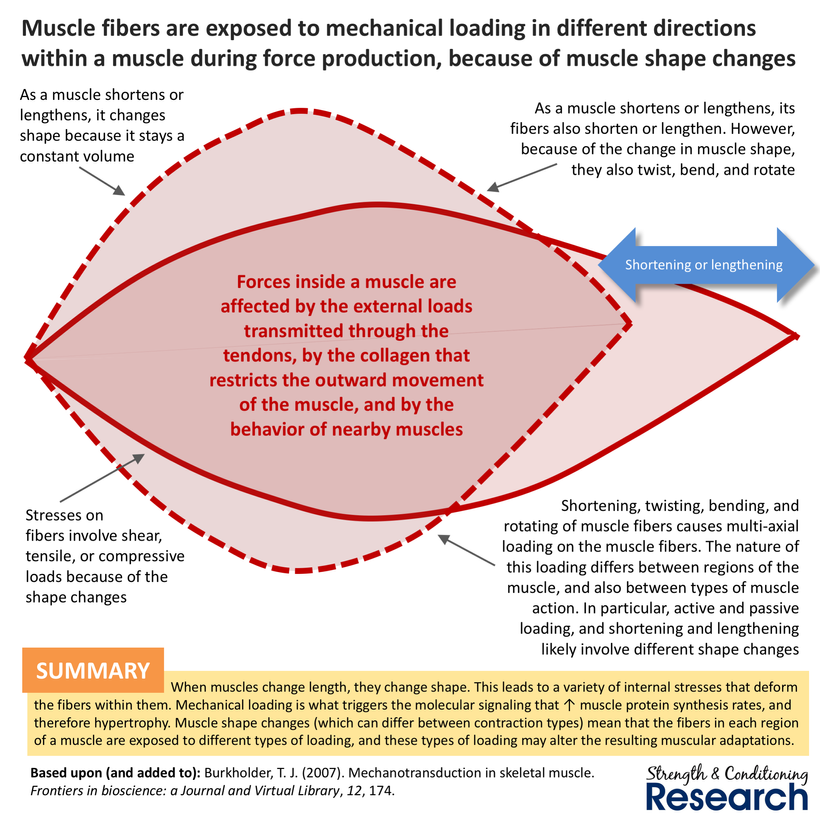
.
Conclusions
Strength training with lighter loads causes smaller strength gains than training heavier loads, even when the same amount of muscle growth occurs. These smaller strength gains can be attributed to: [1] smaller increases in the ability to coordinate an exercise with a heavy load (heavier load training involves practicing a lift with a weight that is closer to the weight used in the strength test), [2] smaller increases in voluntary activation (heavier load sets involve much less central nervous system fatigue and therefore stimulate greater increases in the ability to recruit high-threshold motor units after a workout), [3] smaller tendon adaptations (heavier load training involves higher tendon stress, which is likely what stimulates tendons to increase in stiffness), and [4] smaller increases in specific tension due to smaller increases in lateral force transmission (for reasons that are not clear).

